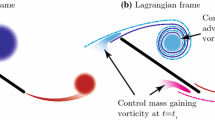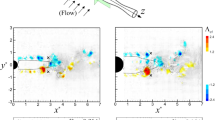Abstract
Using Lagrangian techniques to find transport barriers in complex, aperiodic flows necessitates a careful consideration of the available dimensional support (3D versus 2D) and temporal resolution of the data to be analyzed, a particular challenge in experimental data acquisition. To illustrate and diagnose the detrimental effects that can manifest in the computed Lagrangian flow maps and Cauchy–Green strain tensor that are calculated as part of most Lagrangian coherent structure analyses, planar finite-time Lyapunov exponent (FTLE) fields are computed from analytically defined, experimentally collected, and numerically simulated velocity fields. The FTLE fields calculated using three-component, three-dimensional velocity information (3D FTLE) are compared with calculations using two-dimensional data considering only the in-plane velocities (2D FTLE), data that are typically gathered during fluid dynamics experiments. In some regions, where the vortex rotation axis is perpendicular to the plane of interest, the 2D FTLE may perform well. However, in regions where the vortex rotation axis has a non-zero component parallel to the plane of interest, whole structures can fail to be captured by the 2D FTLE. A quantitative analysis of the error in the 2D FTLE field as it relates to instantaneous vorticity deviation core angle is conducted using Hill’s spherical vortex and the wake of a bioinspired pitching panel. The effect of decreasing temporal resolution is studied using simulated 3D experiments of a fully turbulent channel flow, where the time resolution of the velocity data is artificially degraded. The resultant 3D FTLE fields progressively worsen with degrading velocity field temporal resolution by the visible elongation of coherent structures in the streamwise direction, indicative of the poorly resolved intermediate velocity fields. This effect can be mitigated with a simple method that invokes Taylor’s frozen eddy hypothesis. Both dimensional support and temporal resolution problems in experimental velocity fields can cause major errors in the resulting FTLE fields. With fundamental understanding about the flow field of interest, such as local vortex orientation or relevant length and time scales, some of the pitfalls may be avoided.
Graphical abstract













Similar content being viewed by others
References
Allshouse MR, Peacock T (2015) Refining finite-time Lyapunov exponent ridges and the challenges of classifying them. Chaos Interdiscip J Nonlinear Sci 25(8):087,410
Balasuriya S, Ouellette NT, Rypina II (2018) Generalized Lagrangian coherent structures. Phys D Nonlinear Phenom 372:31–51
Banisch R, Koltai P (2017) Understanding the geometry of transport: diffusion maps for Lagrangian trajectory data unravel coherent sets. Chaos Interdiscip J Nonlinear Sci 27(3):035,804
Beron-Vera F, Olascoaga M, Goni G (2008) Oceanic mesoscale eddies as revealed by Lagrangian coherent structures. Geophys Res Lett 35:L12603
Beron-Vera FJ (2010) Mixing by low- and high-resolution surface geostrophic currents. J Geophys Res Oceans 115(C10):C006006
Blazevski D, Haller G (2014) Hyperbolic and elliptic transport barriers in three-dimensional unsteady flows. Phys D Nonlinear Phenom 273:46–62
Bose C, Sarkar S (2018) Investigating chaotic wake dynamics past a flapping airfoil and the role of vortex interactions behind the chaotic transition. Phys Fluids 30(4):047,101
Bourgeois J, Sattari P, Martinuzzi R (2012) Coherent vortical and straining structures in the finite wall-mounted square cylinder wake. Int J Heat Fluid Flow 35:130–140 [7th symposium on turbulence and shear flow phenomena (TSFP7)]
BozorgMagham AE, Ross SD (2015) Atmospheric Lagrangian coherent structures considering unresolved turbulence and forecast uncertainty. Commun Nonlinear Sci Numer Simul 22(1):964–979
Chong MS, Perry AE, Cantwell BJ (1990) A general classification of three-dimensional flow fields. Phys Fluids A 2(5):765–777
du Toit P, Marsden J (2010) Horseshoes in hurricanes. J Fixed Point Theory Appl 7:351–384. https://doi.org/10.1007/s11784-010-0028-6
Froyland G, Padberg-Gehle K (2015) A rough-and-ready cluster-based approach for extracting finite-time coherent sets from sparse and incomplete trajectory data. Chaos 25(8):087406
Froyland G, Santitissadeekorn N, Monahan A (2010) Transport in time-dependent dynamical systems: finite-time coherent sets. Chaos Interdiscip J Nonlinear Sci 20(4):043116
Green MA, Rowley CW, Haller G (2007) Detection of Lagrangian coherent structures in three-dimensional turbulence. J Fluid Mech 572:111–120
Green MA, Rowley CW, Smits AJ (2011) The unsteady three-dimensional wake produced by a trapezoidal pitching panel. J Fluid Mech 685:117–145
Haller G (2002) Lagrangian coherent structures from approximate velocity data. Phys Fluids 14(6):1851–1861
Haller G (2011) A variational theory of hyperbolic Lagrangian coherent structures. Phys D Nonlinear Phenom 240(7):574–598
Haller G (2015) Lagrangian coherent structures. Annu Rev Fluid Mech 47:137–162
Haller G, Hadjighasem A, Farazmand M, Huhn F (2016) Defining coherent vortices objectively from the vorticity. J Fluid Mech 795:136–173
Hernández-Carrasco I, López C, Hernández-García E, Turiel A (2011) How reliable are finite-size Lyapunov exponents for the assessment of ocean dynamics? Ocean Model 36(3–4):208–218
Hill MJM (1894) On a spherical vortex. Philos Trans R Soc Lond (A) 185:213–245
Hunt JCR, Wray AA, Moin P (1988) Eddies, stream, and convergence zones in turbulent flows. Center for Turbulence Research Report CTR-S88
Jeong J, Hussein F (1995) On the identification of a vortex. J Fluid Mech 285:69–94
Karrasch D, Haller G (2013) Do finite-size Lyapunov exponents detect coherent structures? Chaos Interdiscip J Nonlinear Sci 23(4):043,126
Keating SR, Smith KS, Kramer PR (2011) Diagnosing lateral mixing in the upper ocean with virtual tracers: Spatial and temporal resolution dependence. J Phys Oceanogr 41(8):1512–1534
Kim J, Moin P, Moser R (1987) Turbulence statistics in fully developed channel flow at low Reynolds number. J Fluid Mech 177:133–166
King JT, Kumar R, Green MA (2018) Experimental observations of the three-dimensional wake structures and dynamics generated by a rigid, bioinspired pitching panel. Phys Rev Fluids 3(3):034,701
Kourentis L, Konstantinidis E (2011) Uncovering large-scale coherent structures in natural and forced turbulent wakes by combining PIV, POD, and FTLE. Exp Fluids 52(3):749–763
Kumar R, King JT, Green MA (2016) Momentum distribution in the wake of a trapezoidal pitching panel. Mar Technol Soc J 50(5):9–23
Kumar R, King JT, Green MA (2018) Three-dimensional pitching panel wake: Lagrangian analysis and momentum distribution from experiments. AIAA J. https://doi.org/10.2514/1.J056621
Leung S (2011) An Eulerian approach for computing the finite time Lyapunov exponent. J Comput Phys 230(9):3500–3524
Leung S (2013) The backward phase flow method for the Eulerian finite time Lyapunov exponent computations. Chaos Interdiscip J Nonlinear Sci 23(4):043,132
Miron P, Vétel J (2015) Towards the detection of moving separation in unsteady flows. J Fluid Mech 779:819–841
Mulleners K, Raffel M (2011) The onset of dynamic stall revisited. Exp Fluids 52(3):779–793
O’Farrell C, Dabiri JO (2014) Pinch-off of non-axisymmetric vortex rings. J Fluid Mech 740:61–96
Olcay AB, Pottebaum TS, Krueger PS (2010) Sensitivity of Lagrangian coherent structure identification to flow field resolution and random errors. Chaos Interdiscip J Nonlinear Sci 20(1):017506
Poje AC, Haza AC, Özgökmen TM, Magaldi MG, Garraffo ZD (2010) Resolution dependent relative dispersion statistics in a hierarchy of ocean models. Ocean Model 31(1–2):36–50
Rempel EL, Chian ACL, Brandenburg A, Muñoz PR, Shadden SC (2013) Coherent structures and the saturation of a nonlinear dynamo. J Fluid Mech 729:309–329
Rockwood MP, Taira K, Green MA (2016) Detecting vortex formation and shedding in cylinder wakes using Lagrangian coherent structures. AIAA J 55:15–23
Shadden S, Lekien F, Marsden J (2005) Definition and properties of Lagrangian coherent structures from finite-time Lyapunov exponents in two-dimensinal aperiodic flows. Phys D 212:271–304
Sulman MHM, Huntley HS, Lipphardt BL Jr, Kirwan AD Jr (2013) Leaving flatland: diagnostics for Lagrangian coherent structures in three-dimensional flows. Phys D Nonlinear Phenom 258:77–92
Tang W, Walker P (2012) Finite-time statistics of scalar diffusion in Lagrangian coherent structures. Phys Rev E 86(4):045,201
Taylor GI (1938) The spectrum of turbulence. Proc R Soc Lond Ser A Math Phys Sci 164(919):476–490
You G, Leung S (2018) An improved Eulerian approach for the finite time Lyapunov exponent. J Sci Comput 76(3):1407–1435
Zhou J, Adrian RJ, Balachandar S, Kendall TM (1999) Mechanisms for generating coherent packets of hairpin vortices in channel flow. J Fluid Mech 387:353–396
Acknowledgements
The authors would like to thank Steven Brunton for his contributions and conversations that fed into the content of this paper. This work was supported by the Air Force Office of Scientific Research under AFOSR Award no. FA9550-14-1-0210.
Author information
Authors and Affiliations
Corresponding author
Additional information
Publisher's Note
Springer Nature remains neutral with regard to jurisdictional claims in published maps and institutional affiliations.
Rights and permissions
About this article
Cite this article
Rockwood, M.P., Loiselle, T. & Green, M.A. Practical concerns of implementing a finite-time Lyapunov exponent analysis with under-resolved data. Exp Fluids 60, 74 (2019). https://doi.org/10.1007/s00348-018-2658-1
Received:
Revised:
Accepted:
Published:
DOI: https://doi.org/10.1007/s00348-018-2658-1




